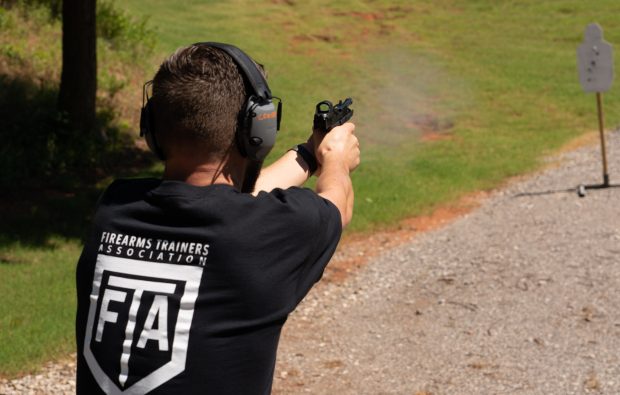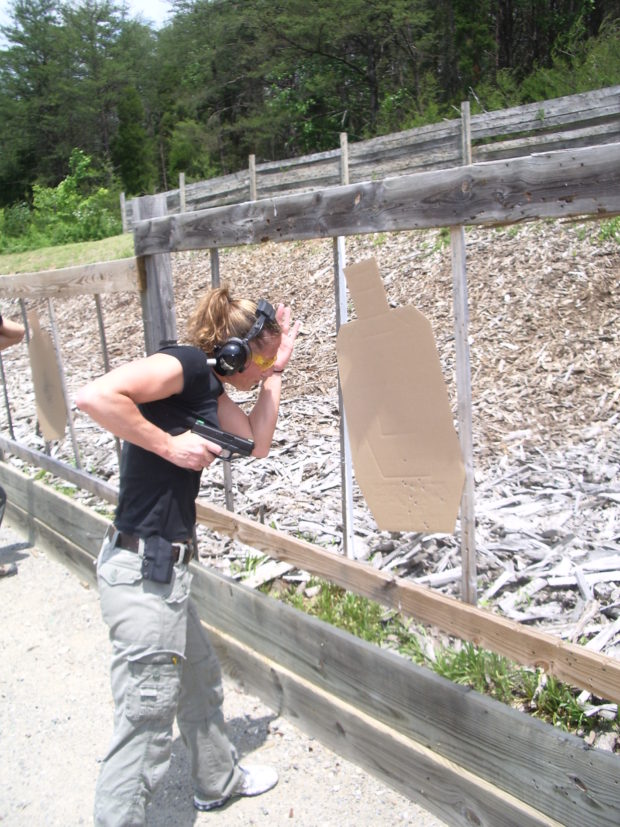*This is a guest post by my friend Steve Moses extolling the importance of leaning how to shoot from a retention position and fight in close quarters with your carry pistol. Steve will be hosting my upcoming Extreme Close Quarters Gunfighting class where we cover those topics in great detail. If this article inspires you to learn more, I’d love to see you there.
– Greg
Adaptive Defensive Pistol skills may come into play when a weaker person is physically attacked by a larger, more powerful, or even more physically skilled violent criminal attacker at distances in which there is a high probability that even if the defender is armed they may be injured or killed. Personal weapons such as hands, fists, feet, knives or other cutting instruments, and blunt objects such as hammers are frequently the weapons of choice used against men and women at either close contact or direct contact distances. Most armed defenders have never contemplated the need for retention shooting techniques and skills and are likely far more vulnerable to being injured or worse in a deadly force encounter than they may be aware of.
If all that we teach in our classes is how to shoot a handgun at full extension, then we can probably expect our students to default to that position under pressure regardless of their proximity to the attacker. While the “average” distance of a civil sector defensive shooting is believed by many to be between three to five yards, handguns have been frequently used for defensive purposes at far closer distances in which there is a strong likelihood that the defender may be overpowered before they can successfully defend themselves.

Practicing this type of shooting is important, but it is only one piece of the puzzle.
The retention shooting method I teach is largely based upon what I learned from Craig Douglas in his Extreme Close Quarters Concepts course many years ago. I would definitely encourage other firearm trainers to attend the same course or train under one of the many instructors that trained under Douglas that are qualified to properly teach retention shooting. In my opinion, students should not be introduced to retention shooting until they have been trained in the basics of shooting at full extension, with much emphasis placed on safety in the form of trigger control, muzzle discipline, and efficient presentation from a concealed holster.
Proper retention shooting is designed to stand up under heavy forward pressure in anticipation that the defender may become entangled with a stronger attacker and minimizes the chances that that the defender will shoot him or herself during a melee whether upright or on the ground. It emphasizes the importance of a forward-leaning athletic base with a lowered center of gravity and most of the defender’s weight positioned over the balls of the feet.
This method promotes the importance of staying upright, mobile, and ultimately conscious. The defender should adopt the exact same index points every time, whether strong-hand only or freestyle, that allows him or her to control the trajectory of any rounds fired from that position. Consequently, the defender should always know where the muzzle is oriented as well as when one of his or her own body parts is momentarily in the line of fire. This is true whether or not the defender’s arm, hand, and even leg is in front of or behind the attacker. In addition, the student needs to know how to position his or her non-firing arm so that it can be kept clear of the muzzle as well as how to utilize that same arm to shield their head from punches and protect the drawn handgun from being stripped from their hand.
The ability to competently shoot from a strong retention shooting position may accomplish the following:
- Decrease the odds that the student is injured or killed if attacked at a close distance against another person who is unarmed but stronger and more skilled at violence or even bearing an impact weapon.
- Increase the odds that the student will not draw a handgun prematurely if caught up in an encounter in which the circumstances are ambiguous and that the immediate presentation of a concealed handgun might get him or her charged with a brandishing or aggravated assault. Muggers committing strong-arm robberies, angry motorists, and intoxicated persons may suddenly attack with little to no discernible notice with the express intent of catching the defender off-guard. Students who have been trained to detect pre-assault clues and are able to manage distance combined with training in retention shooting may be less likely to threaten another person with lethal force just because they were, and I quote “scared.” The handgun should never come out of the holster if the attacker is incapable of seriously injuring or killing the defender or in retaliation to having been “punched in the nose” if the attacker immediately backs off and does not otherwise present an imminent deadly threat.
Trainers who believe that all concealed carriers should have close-distance retention shooting skills have a choice between either directing students to other qualified instructors or teaching proper retention shooting themselves. We do need to avoid teaching something that we are not qualified to teach. Improper techniques can subject our students to the risk of a significant injury during training, not to mention during an actual violent attack.

A piece of the shooting skills puzzle you may not have (yet) acquired.

